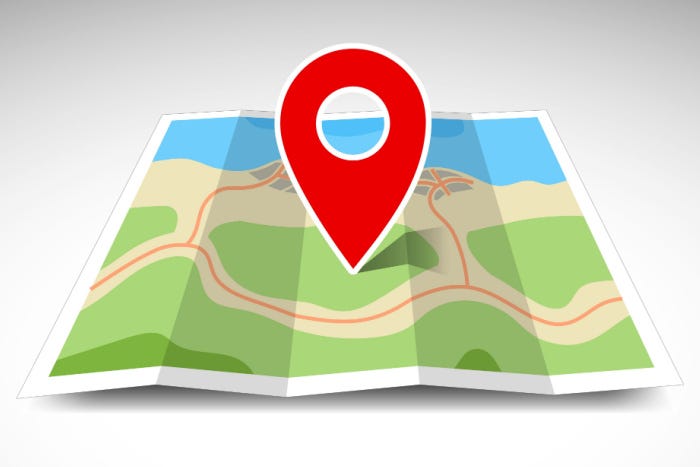International Supply Chains are Still Searching for Their "GoogleMaps"
Welcome to the 106th edition of The LogTech Letter. TLL is a weekly look at the impact technology is having on the world of global and domestic logistics. Last week, I’m discussed how I approached coverage of Slync’s troubles over the summer and whether the appointment of a new CEO might herald a real change. This week, guest poster Grant Sernick, director of sales at logistics technology provider 3rdWave, explains why the visibility market has something to learn from GoogleMaps.
As a reminder, this is the place to turn on Fridays for quick reflection on a dynamic, software category, or specific company that’s on my mind. You’ll also find a collection of links to stories, videos and podcasts from me, my colleagues at the Journal of Commerce, and other analysis I find interesting.
For those that don’t know me, I’m Eric Johnson, senior technology editor at the Journal of Commerce and JOC.com. I can be reached at eric.johnson@spglobal.com or on Twitter at @LogTechEric.
When I was growing up, getting lost was part of the adventure of going anywhere. We used to carry map books in the car that would enable us to get a sense of where we were, and a bearing on where we should be heading. Experience would allow us to approximate how long it would take to get to different places, but traffic conditions, weather, and accidents could make our estimations vary wildly. Being late (or very late) wasn’t a surprise for anyone.
I also remember the great innovation that was MapQuest in the mid-2000s. As if by magic, you were now able to input your starting point and destination, and the internet site would map out, turn-by-turn, the optimal way of getting there. It didn’t really matter that you needed to use a desktop computer. You just needed to plan ahead, print it out, and take it with you.
Then GPS was introduced. It enabled real-time positioning on a map, so when you combined this technology with MapQuest, you were able to achieve real-time positioning with turn-by-turn capability on the go, without need for pre-planning or printers.
MapQuest and GPS were incredible new technological inventions that worked their way into our lives, however they didn’t practically change the way we lived. Yes, we planned a little better (MapQuest) and then a little less (GPS). We were a little more on time because we didn’t get lost. But aside from that, life in 2006 was not much different than life in 1985.
Things changed when Waze broke onto the scene. This little Israeli startup changed the game, and materially changed our lives. Waze took MapQuest, and with the help of the mobile internet connected other users together to understand traffic conditions. With this evolution, they were able to unlock implications…and it is those implications that created a whole new set of capabilities and value. With Waze, you didn’t just know where you were all the time, but you were able to ascertain the optimal way of getting from one point to another, in real time. More than that, you could now know where speed traps were, red-light cameras, debris on the highway, potholes, and more. Waze was transformative.
Waze (and subsequently Google Maps, Apple Maps, etc.) was a platform that could be built on and improved. Now you could have integrated restaurants that had ratings and where you could make reservations. You could find gas stations. Cars were able to transform from mechanical objects that had built-in computers into computers that had wheels (Tesla). Businesses were able to leverage this technology and start optimizing fleets of trucks like never before. It enabled the gig-economy for transportation work, where more people could participate while costs got reduced.
As we look back on our world from 2022 and how different it is from 2006, the creation of Waze was a seminal point. The consumer transportation industry has been upended by companies like Uber and Lyft that are predicated on this technology. Retail has been transformed by Amazon, where next-day home delivery is a standard for just about everyone. Employer-employee relationships have been upended with the introduction of the gig-economy.
By combining maps, GPS, and the internet, an explosion of new capabilities, business opportunities, and value creation was unleashed.
How does this relate to visibility in supply chains? Cracking the nut on supply chain visibility similarly requires combining three distinct technologies, each technology important in its own right. Each one, when implemented, will improve visibility in its own way. When combined, however, these technologies will transform the way businesses operates and enable new and unforeseen business opportunities:
Location and status - Accurate position and status of shipments in real time (or near-real time)
Supply Chain Context Engine - Ability to standardize and contextualize the ‘real’ world transactional data to enable productive interactions between supply chain players (the enterprise, logistics providers, customs brokers, customers, etc.)
Enterprise Context Engine - Ability to contextualize the extended processes of the ‘corporate’ world, enabling productive and collaborative decision-making within and across an enterprise (e.g., BCO, shipper, importer/exporter)
As new technologies pop up in the supply chain space, I see the world very similarly to the way it was pre-Waze. There are an infinite number of technology players that solve part of the visibility problem. A quick look at Pitchbook’s Supply Chain Tech Report for 2022 shows massive investments in companies that cover 2 of the required elements, but not all three, such as:
Project44 ($420M) - a platform that connects the largest network of carriers, shippers, and logistics providers [Location and status + Supply Chain Context]; Flexport ($935M) - a freight forwarder with superior technology [Location and status + Supply chain context]; Relex ($566M) - a retail planning platform [Location and status + Enterprise Context]; Assent Compliance ($447M) - a supply chain sustainability platform [Supply chain context + Enterprise context].
Each of these software technologies is a marvel in its own right. They combine existing and new technologies in a way that adds value. Notwithstanding this, however, one would see the supply chains in 2022 similar to supply chains of 2006. Sure things are better, but not meaningfully so.
It isn’t until all three of the aforementioned technologies are combined will we see meaningful change in the management of global supply chains. When this nut is cracked at scale, we will see an explosion of capabilities and value that will be unparalleled in recent memory. I am hopeful we are not too far away, but I am certain we aren’t there yet.
TPMTech Agenda is Live!
Because we put editorial-focused discussion first at the Journal of Commerce, we generally know pretty far in advance exactly what we want to discuss at our events. TPMTech is no different. The agenda for an event more than four months away went live this week. There’s lots more speakers to announce, a few more sessions to come, and a new wrinkle we’re adding this year that’ll be unlike anything you’ve seen at a logistics technology conference. Use the promo code below to get a 25 percent discount on TPMTech registration, or a bundle with TPM.
Neal Peart Lyrics of the Week:
Like a million little doorways
All the choices we made
All the stages we passed through
All the roles we played
So many different directions
Our separate paths might have turned
With every door that we opened
Every bridge that we burned
Here’s a roundup of recent pieces on JOC.com from my colleagues and myself (note: there is a paywall):
It may seem relatively insignificant, but Geodis’ announcement Thursday that it had used an automation software specialist to make its process for answering rote queries in RFPs more efficient is actually pretty telling. Process automation is starting to become part of the fabric of the logistics industry. For instance, a piece I wrote in April about Ocean Network Express using WNS to deploy RPA for customer service enquiries. Or traction for Rippey AI (formerly RPA Labs).
In the category that just keeps on giving, visibility provider Shippeo snagged a $40 million round this week (taking it to $110 million in all) to expand its footprint in North American and Asia. On the former front, Shippeo tied up a deal with e2open to accelerate its access to US shippers.
My colleague Bill Cassidy wrote about a group of 30 LTL carriers, brokers, and 3PLs agreeing to use a standardized electronic bill of lading, a long-running and much awaited development in that mode.
And here are some recent discussions, reports, and analysis I found interesting:
Worthwhile blog from Gravity Supply Chain Solutions on technology that forwarders need to prioritize.
Dave Ross is back at it, this time with a treatise on the trends he’s seeing in the world of 3PLs.
Joe Lynch’s Logistics of Logistics podcast had serial entrepreneur Marc Held on to discuss his latest venture, Fishtail, which is aiming to improve the freight insurance market.
Some upcoming events I’ll be involved in:
Joining an all-star crew from Searoutes, Intelligent Audit and Vizion at 11 am Nov. 1 to discuss why context is important when using visibility data
Disclaimer: This newsletter is in no way affiliated with The Journal of Commerce or S&P Global, and any opinions are mine only.





